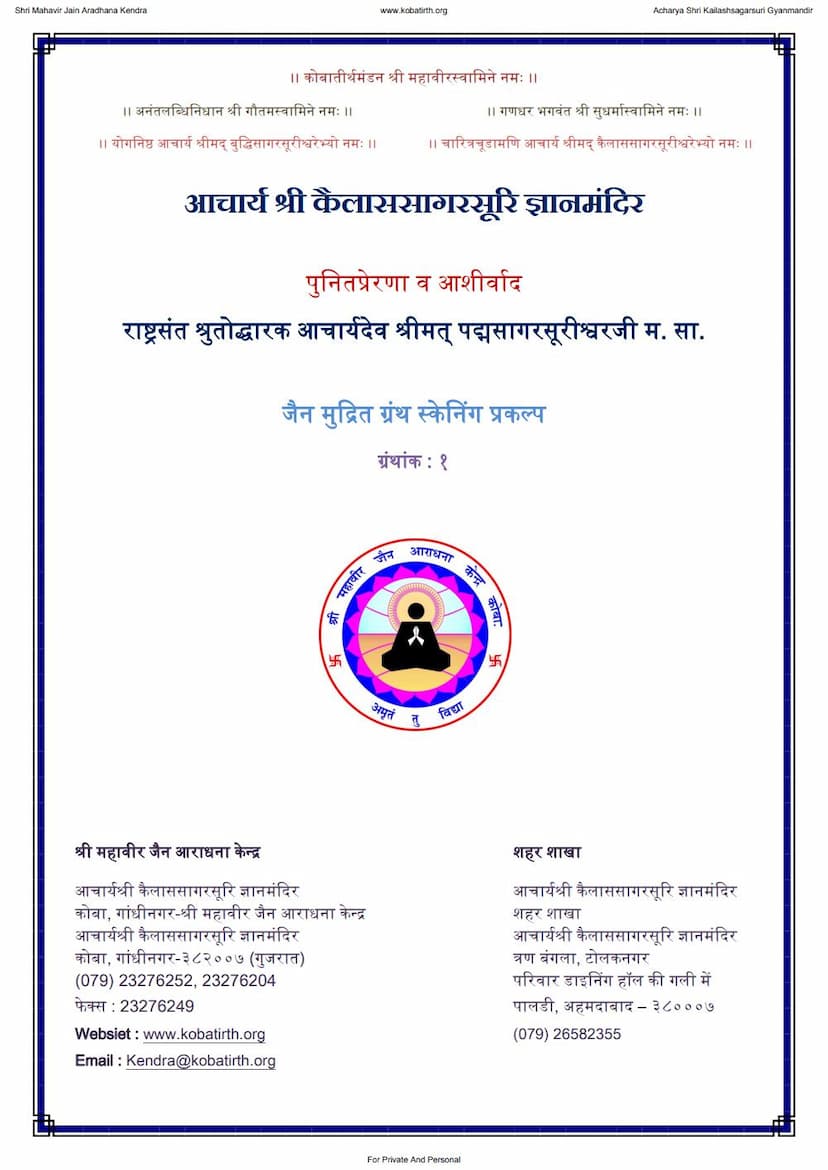Vyavahar Sutram Part 06
Added to library: September 2, 2025

Summary
This document is the sixth part of the Vyavahara Sutram, a foundational Jain text authored by Munichandrasuri. The publication is from Omkarsuri Gyanmandir, Surat. This particular volume, Part 6, covers the tenth Uddeśaka (chapter) of the Vyavahara Sutram, specifically dealing with verses (gathas) from 3810 to 4675.
The text is presented with the commentary and explanations of Acharya Malayagiri Suri, and includes the Niryukti-Bhashya. The editorial work and research for this edition were done by Acharya Vijay Munichandrasuri, with assistance from Muni Divyaratnasurivijay.
Key aspects highlighted in the introductory pages:
- Content of Part 6: This volume focuses on the 10th Uddeśaka, encompassing Niryukti-Bhashya gathas 3810 to 4675, along with Malayagiri Suri's commentary.
- Editorial Process: The text was researched and edited based on various palm-leaf manuscripts and materials compiled by Agamaprabhakar Muni Shri Punyavijayji.
- Nature of Vyavahara Sutram: It is described as a Cheda-granth, dealing with topics like penance and purification for monks and nuns. Therefore, its reading and study are restricted to those with appropriate authority, as per the Guru's instructions.
- Publication: The sutram is vast and is published in six parts. This edition aims to fulfill the needs of monks traveling during their wanderings.
- Scholarly Collaboration: The editor, Acharya Shri Munichandrasuri, collaborated with several esteemed scholars and Acharyas, including Acharya Shri Rajasekharasuri, Acharya Shri Kulachandrasuri, Acharya Shri Punyaratnasuri, Acharya Shri Yashoratnasuri, Pandit Mukti Chandra, and Pandit Muni Chandra, for the accurate research and editing of this important text.
- Benefactors: The publication was made possible through the contributions of various Jain Sanghas and individuals who provided "Jnana-dravya" (funds for knowledge dissemination).
- Special Note on Pagination: The publication uses a "Pothi" (scroll-like) format for pagination, where one printed page is represented by two "Pothi" pages (e.g., Page 2 of the book corresponds to pages 2A and 2B in the Pothi format). This is to maintain consistency with the original manuscript pagination.
The detailed table of contents (from page 11 onwards) outlines the specific topics covered in the 10th Uddeśaka, which include:
- The nature of "Yavamadhya-chandratapratima" and "Vajramadhya-chandratapratima" (specific descriptions related to monastic practices or symbols).
- Rules and procedures for receiving alms (bhiksha).
- Protocols related to various types of obstacles (upasarga) and how to endure them.
- Different types of alms-seeking (annayochchha).
- Practices related to alms-gathering and its regulations.
- Rules concerning pregnant women and infants in relation to alms.
- Detailed guidelines on what is permissible and what is forbidden in various situations (vyavahara).
- Discussions on penance (prayaśchitta) in different contexts (time, place, type of sin).
- The five types of Vyavahara: Agama, Shruta, Ājñā, Dhāraṇā, and Jīta.
- The significance and practice of adhering to Ājñā (commandments) and Ārādhanā (devotion/practice).
- The concept of Ābhava (non-manifestation) and its relation to different types of penance.
- Guidelines on specific locations and their suitability for monastic dwelling and practices.
- The importance of respecting seniority and knowledge in the monastic order (sthāvira bhūmi).
- Discussions on various types of training and learning for monks (śaikṣa bhūmi).
- The intricate rules and conduct related to the monastic community (gaṇa) and their interactions.
- The role and types of Āchāryas (teachers) in guiding the monastic path.
- The stages and requirements for initiating disciples (śiṣya parīkṣā).
- Detailed procedures for performing penance and purification.
- The significance of fasting and its different forms.
- The process of renunciation and ascetic practices leading to liberation (nirjarā).
- The stages and methods of death by voluntary starvation (samlekhana).
- The proper conduct in different circumstances of death or departure from life.
- The concept of "Vyavahara" itself, being the conduct that governs the Jain monastic life, and how it is derived from Agama (scriptures), Shruta (learning), Ājñā (commands), Dhāraṇā (retention/memory), and Jīta (practice/experience).
- The specific importance of knowledge of scriptures and conduct in different situations.
The content is highly detailed, offering a systematic breakdown of rules, procedures, and philosophical underpinnings of Jain monasticism, particularly focused on the practical application of principles in daily life and during challenging situations. The text emphasizes the importance of proper conduct, adherence to teachings, and the rigorous pursuit of spiritual discipline.